Lucifer’s luster was restored by Romanticism’s Miltonic iconography, within which the beauty and majesty of Paradise Lost’s fallen archangel was fully realized. Some of that magnificence survived in certain post-Romantic renderings of Milton’s Satan, the most significant of which was undeniably Gustave Doré’s series of wood engravings for an 1866 edition of Paradise Lost, which would become the most popular depiction of Milton’s epic. Illustrators of Milton in the early twentieth century began to drift from the Romantic vision of Milton’s Satan, however, and as twentieth-century popular culture would return the Devil to his erstwhile monstrousness, it is evident that there is a need for modern-day Miltonic iconography which returns Satan to his Romantic reimagining—that is, which recalls his Miltonic makeover.
Gustave Doré (1832 – 1883)
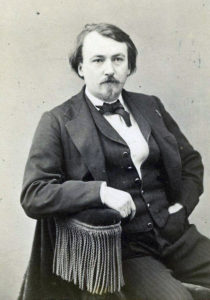 Doré was an almost superhumanly prolific artist, and he was to become the most accomplished illustrator of the nineteenth century. The French-born Paul Gustave Louis Christophe Doré was encouraged to pursue his artistic talents by his mother, and upon the death of his father, who certainly had reservations about his son going down this path, the incredibly industrious Doré became the chief support of his family. “Doré’s output is mind-boggling,” note Robert Woof, Howard J. M. Hanley, and Stephen Hebron. “Biographers claim he illustrated more than two hundred and twenty books with more than ten thousand graphics,” and “including paintings and sculptures he averaged about one work of art every day for thirty years” (Paradise Lost: The Poem and its Illustrators, p. 22). Doré’s main method of illustrating was wood engraving, and he amassed some forty engravers to assist in his speedy output. The 1860s saw Doré, ever eager to raise the prestige of his work, take on a number of literary classics, resulting in the creation of scores of incredible engravings for Dante’s Divine Comedy, Cervantes’ Don Quixote, the Holy Bible, and of course Milton’s Paradise Lost. These illustrations would be reproduced in multiple editions making their way across the globe, and Doré became particularly popular in England: a Doré gallery, established in New Bond Street, spanned the years 1868–1914, outliving the artist by more than thirty years. Doré was approached by Cassell, Petter & Galpin—the publisher responsible for the English edition of Doré’s Don Quixote in 1864 and, more importantly, the English edition of Doré’s Bible, a must-have for bourgeois households, in 1866—to execute fifty engravings for a new English edition of Paradise Lost. Doré’s vision of the Miltonic was realized in 1866, and it was to become the most well-known depiction of Milton’s epic poem, especially its Satan.
Doré was an almost superhumanly prolific artist, and he was to become the most accomplished illustrator of the nineteenth century. The French-born Paul Gustave Louis Christophe Doré was encouraged to pursue his artistic talents by his mother, and upon the death of his father, who certainly had reservations about his son going down this path, the incredibly industrious Doré became the chief support of his family. “Doré’s output is mind-boggling,” note Robert Woof, Howard J. M. Hanley, and Stephen Hebron. “Biographers claim he illustrated more than two hundred and twenty books with more than ten thousand graphics,” and “including paintings and sculptures he averaged about one work of art every day for thirty years” (Paradise Lost: The Poem and its Illustrators, p. 22). Doré’s main method of illustrating was wood engraving, and he amassed some forty engravers to assist in his speedy output. The 1860s saw Doré, ever eager to raise the prestige of his work, take on a number of literary classics, resulting in the creation of scores of incredible engravings for Dante’s Divine Comedy, Cervantes’ Don Quixote, the Holy Bible, and of course Milton’s Paradise Lost. These illustrations would be reproduced in multiple editions making their way across the globe, and Doré became particularly popular in England: a Doré gallery, established in New Bond Street, spanned the years 1868–1914, outliving the artist by more than thirty years. Doré was approached by Cassell, Petter & Galpin—the publisher responsible for the English edition of Doré’s Don Quixote in 1864 and, more importantly, the English edition of Doré’s Bible, a must-have for bourgeois households, in 1866—to execute fifty engravings for a new English edition of Paradise Lost. Doré’s vision of the Miltonic was realized in 1866, and it was to become the most well-known depiction of Milton’s epic poem, especially its Satan.
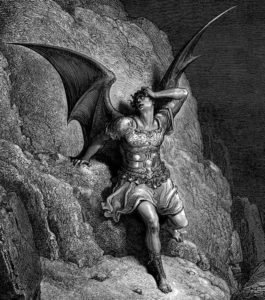 For his unique style, which intermingled intense epic heroism with visions of grotesquerie, Doré was appropriately dubbed “the last of the Romantics,” and indeed Doré’s Satan is, in a sense, an amalgamation of the various Romantic interpretations of the fallen archangel: inhabiting vast, sublime landscapes much reminiscent of Martin’s mezzotints, Doré’s Satan is rendered in a human and heroic manner, donning quasi-classical garb and alternating angel and bat wings, and often striking Fuselian melodramatic poses. Yet Doré improved upon Romantic renditions of the Miltonic Satan in a significant respect: the inclusion of Satan’s supporters. The Romantic Satan was undeniably sublime, but with very few exceptions—namely Barry’s Satan and His Legions Hurling Defiance toward the Vault of Heaven (ca. 1792–94) and Blake’s Satan calling up his Legions (1807)/Satan arousing the Rebel Angels (1808)—the figure of Satan was rather isolated, and the deep sense of loyalty shared between the rebel chief and his associates was undeniably lacking. Doré’s illustrations, on the other hand, splendidly capture the martial brotherhood of the rebel angels, and it serves to enhance Satan’s nobility, as it does in Milton’s poem. Consider, for example, the difference in the depictions of Satan summoning his legions: in the many Romantic treatments of this grand scene, a titanic Satan calls out to an army either entirely out of sight or represented by only a small number of figures included in the frame, whereas in Doré’s treatment Satan is surrounded by masses of his fellow fallen angels, who even in the depths of despair look up at their fearless leader in awe and begin to rise to their feet. This Satan is not as titanic in stature as the Romantic Satan, and we do not even see his face, but Doré captures like no other artist what Satan’s second-in-command claims in the Hell of Paradise Lost: that only he—only his commanding voice—could rouse the rebel angels from their defeat (I.272–82).
For his unique style, which intermingled intense epic heroism with visions of grotesquerie, Doré was appropriately dubbed “the last of the Romantics,” and indeed Doré’s Satan is, in a sense, an amalgamation of the various Romantic interpretations of the fallen archangel: inhabiting vast, sublime landscapes much reminiscent of Martin’s mezzotints, Doré’s Satan is rendered in a human and heroic manner, donning quasi-classical garb and alternating angel and bat wings, and often striking Fuselian melodramatic poses. Yet Doré improved upon Romantic renditions of the Miltonic Satan in a significant respect: the inclusion of Satan’s supporters. The Romantic Satan was undeniably sublime, but with very few exceptions—namely Barry’s Satan and His Legions Hurling Defiance toward the Vault of Heaven (ca. 1792–94) and Blake’s Satan calling up his Legions (1807)/Satan arousing the Rebel Angels (1808)—the figure of Satan was rather isolated, and the deep sense of loyalty shared between the rebel chief and his associates was undeniably lacking. Doré’s illustrations, on the other hand, splendidly capture the martial brotherhood of the rebel angels, and it serves to enhance Satan’s nobility, as it does in Milton’s poem. Consider, for example, the difference in the depictions of Satan summoning his legions: in the many Romantic treatments of this grand scene, a titanic Satan calls out to an army either entirely out of sight or represented by only a small number of figures included in the frame, whereas in Doré’s treatment Satan is surrounded by masses of his fellow fallen angels, who even in the depths of despair look up at their fearless leader in awe and begin to rise to their feet. This Satan is not as titanic in stature as the Romantic Satan, and we do not even see his face, but Doré captures like no other artist what Satan’s second-in-command claims in the Hell of Paradise Lost: that only he—only his commanding voice—could rouse the rebel angels from their defeat (I.272–82).
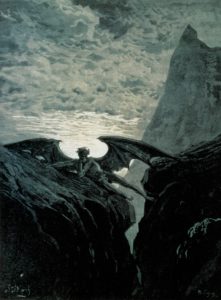 Doré’s vision of Paradise Lost is unique not only for his unmistakable style but his choice of subjects. Many of Doré’s scenes were simply unattempted before, and even those which were depicted countless times over were uniquely imagined by the artist. Some scenes do recall Romantic Satanic iconography in terms of granting Satan “glory sole among / Th’infernal Powers” (PL, IX.135–36), that is, having him upstage the limited number of accompanying characters: Doré’s Satan rearing himself off the lake of fire before Beëlzebub, and his encounter with Sin and Death at the gates of Hell. Other scenes capture the spirit of the Romantic Satan who appears magnificent despite his suffering, such as Satan’s torturous journey through a rocky Chaos, his descent to Earth, his despair atop Mt. Niphates, his introduction to pain after having been bested by the archangel Michael in heavenly battle, his contemplation of the paradisiacal Earth, and his sense of indignation before descending into the slimy serpent. Doré also depicts many somber moments of a lonely Lucifer, such as Satan overlooking Eden from the peak of Mt. Niphates, standing atop a rocky precipice in the midst of cataracts, and treading through the idyllic paradise. Doré’s greatest triumphs, however, are his depictions of Satan suffering and striving with his immense army of rebel angels, sharing with them moments of both horrific doom—being driven out of Heaven, plummeting into Hell as the Almighty’s thunderbolts descend upon them, crying up to Heaven from the floor of Hell as crowds of angelic bodies come crashing down, transforming into serpentine monsters as divine retribution is imposed—as well as heroic defiance—the towering figure of Satan summoning his disarrayed legions, leading them in flight through the underworld, presiding over Pandemonium, and returning to the infernal capitol. There are two scenes from Book IX which suggest Doré was intending to portray a Satan progressively degenerating a la the 1688 Paradise Lost illustrations; in the first Satan is stripped of his celestial armor and dons only a loincloth, and in the second Satan is fully nude, with brittle hair and what appears to be cloven hoofs—a more debased look Doré also strangely uses in one scene from Book VI: the Devil alone in despair after the first day of celestial combat, which is entirely out of place considering Satan’s look in the scenes surrounding this one.
Doré’s vision of Paradise Lost is unique not only for his unmistakable style but his choice of subjects. Many of Doré’s scenes were simply unattempted before, and even those which were depicted countless times over were uniquely imagined by the artist. Some scenes do recall Romantic Satanic iconography in terms of granting Satan “glory sole among / Th’infernal Powers” (PL, IX.135–36), that is, having him upstage the limited number of accompanying characters: Doré’s Satan rearing himself off the lake of fire before Beëlzebub, and his encounter with Sin and Death at the gates of Hell. Other scenes capture the spirit of the Romantic Satan who appears magnificent despite his suffering, such as Satan’s torturous journey through a rocky Chaos, his descent to Earth, his despair atop Mt. Niphates, his introduction to pain after having been bested by the archangel Michael in heavenly battle, his contemplation of the paradisiacal Earth, and his sense of indignation before descending into the slimy serpent. Doré also depicts many somber moments of a lonely Lucifer, such as Satan overlooking Eden from the peak of Mt. Niphates, standing atop a rocky precipice in the midst of cataracts, and treading through the idyllic paradise. Doré’s greatest triumphs, however, are his depictions of Satan suffering and striving with his immense army of rebel angels, sharing with them moments of both horrific doom—being driven out of Heaven, plummeting into Hell as the Almighty’s thunderbolts descend upon them, crying up to Heaven from the floor of Hell as crowds of angelic bodies come crashing down, transforming into serpentine monsters as divine retribution is imposed—as well as heroic defiance—the towering figure of Satan summoning his disarrayed legions, leading them in flight through the underworld, presiding over Pandemonium, and returning to the infernal capitol. There are two scenes from Book IX which suggest Doré was intending to portray a Satan progressively degenerating a la the 1688 Paradise Lost illustrations; in the first Satan is stripped of his celestial armor and dons only a loincloth, and in the second Satan is fully nude, with brittle hair and what appears to be cloven hoofs—a more debased look Doré also strangely uses in one scene from Book VI: the Devil alone in despair after the first day of celestial combat, which is entirely out of place considering Satan’s look in the scenes surrounding this one.
All things considered, Doré’s take on Milton’s Satan is overwhelmingly Romantic, and it was an absolute triumph for the Miltonic-Romantic Lucifer’s legacy that Doré depicted Satan so. The artist’s marvelous illustrations for Milton’s Paradise Lost, like all of his work, saw wide dissemination around the world, and today Doré’s Satan remains the most widely known depiction of Milton’s hellish epic hero. Gustave Doré, “the last of the Romantics,” was responsible for preserving the Romantic vision of Milton’s Satan.
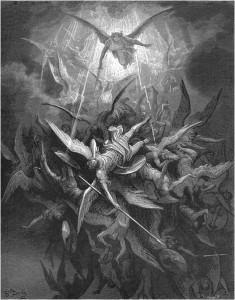
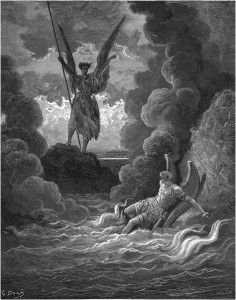
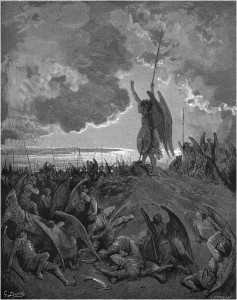
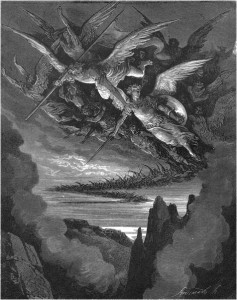
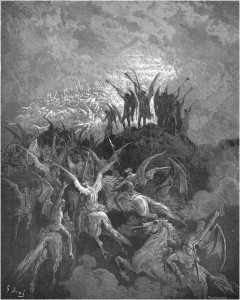
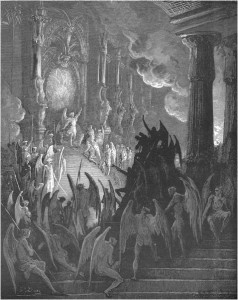
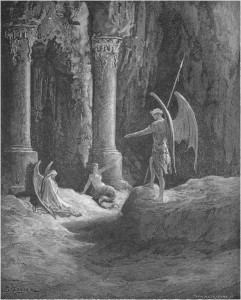
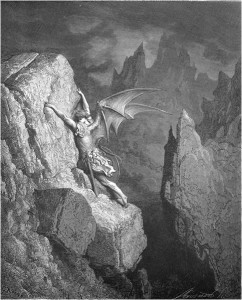
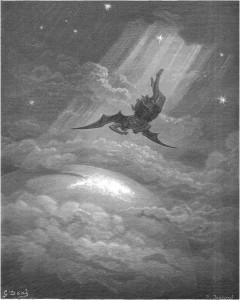
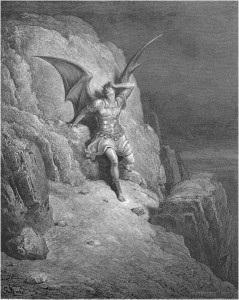
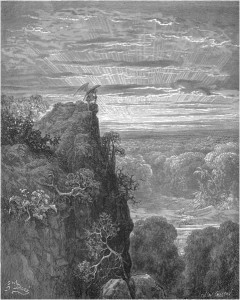
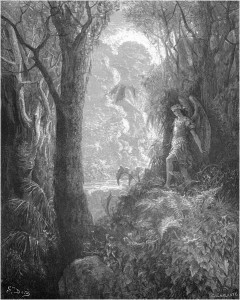
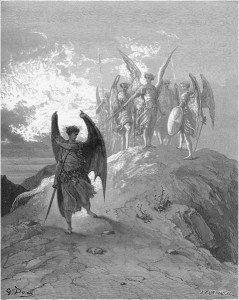
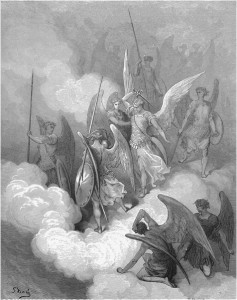
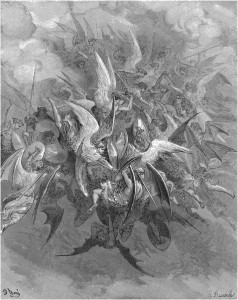
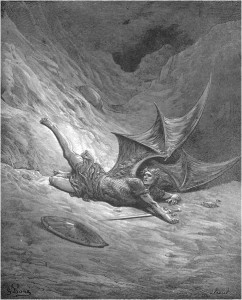
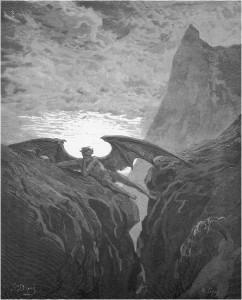
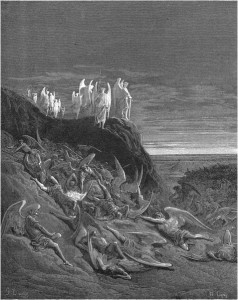
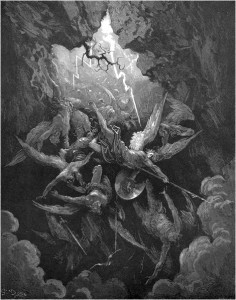
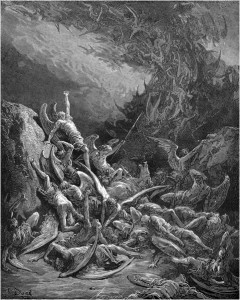
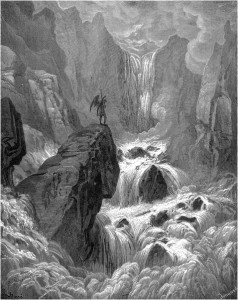
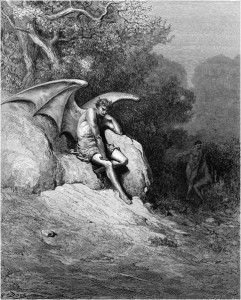
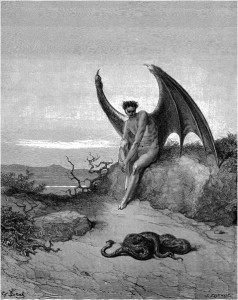
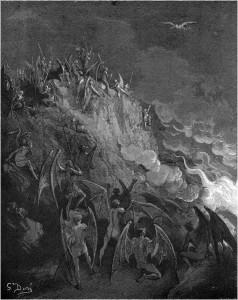
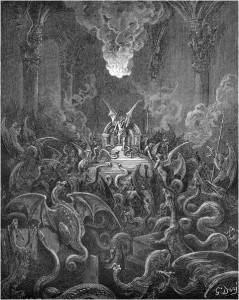
William Strang (1859 – 1921)
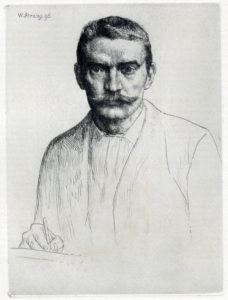 Strang was a Scottish painter and engraver, and one of the first members of the Royal Society of Painter-Etchers and Engravers (now the Royal Society of Painter-Printmakers), established in 1880 and granted a Royal Charter eight years later. Strang studied at the world-renowned UCL (University College London) Slade School of Fine Art under the French artist Alphonse Legros (1837–1911). A multifaceted artist, many of Strang’s works were exhibited at the Royal Academy of Arts and elsewhere. Strang executed a series of twelve illustrations for Milton’s Paradise Lost in 1896 for the publisher John C. Nimmo, only one of which depicts Milton’s Satan: Satan Rising from the Burning Lake. The image is peculiar, particularly Satan’s strange pencil stance, but with his human form, handsome features, fair shoulder-length hair, and feathery angelic wings, Strang’s Satan recalls the fallen rebel angel of Romanticism’s Miltonic iconography.
Strang was a Scottish painter and engraver, and one of the first members of the Royal Society of Painter-Etchers and Engravers (now the Royal Society of Painter-Printmakers), established in 1880 and granted a Royal Charter eight years later. Strang studied at the world-renowned UCL (University College London) Slade School of Fine Art under the French artist Alphonse Legros (1837–1911). A multifaceted artist, many of Strang’s works were exhibited at the Royal Academy of Arts and elsewhere. Strang executed a series of twelve illustrations for Milton’s Paradise Lost in 1896 for the publisher John C. Nimmo, only one of which depicts Milton’s Satan: Satan Rising from the Burning Lake. The image is peculiar, particularly Satan’s strange pencil stance, but with his human form, handsome features, fair shoulder-length hair, and feathery angelic wings, Strang’s Satan recalls the fallen rebel angel of Romanticism’s Miltonic iconography.
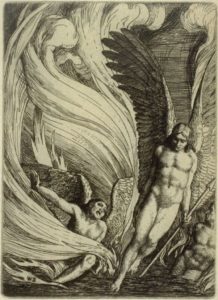
William Hyde (1857 – 1925)
Hyde was an English artist who, like Strang, studied at the Slade School of Fine Art. He specialized in etching, engraving, and mezzotint, and his work, which shunned the Art Nouveau style popular at the time, would see exhibition at the Royal Academy. Hyde was also a popular magazine and book illustrator, most significantly providing the illustrations for the Astolat Press edition of The Poetical Works of John Milton of 1904. Hyde’s Satan, while not particularly imposing in stature, is an angelic-winged nude whose youthful features are wracked with rage and resentment as he struggles to rear himself off the lake of fire with his spear, and as such he harkens back to the fallen archangel of Romantic art.
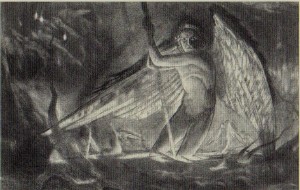
Estella Canziani (1887 – 1964)
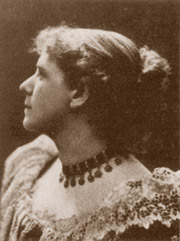 Canziani was an English portrait and landscape painter, as well as a book illustrator and travel writer. The daughter of English painter Louisa Starr (1845–1909) and Italian civil engineer Enrico Canziani (1848–1931), Canziani was formally trained, not least at the Royal Academy Schools like many of the Romantic artists of the Satanic a century before her, and she would go on to exhibit at the Royal Academy in England and Europe. In 1913, Canziani executed Satan awakening his legions, which is rather reminiscent of Doré’s illustrations for Paradise Lost: a preeminent fallen archangel towers in the midst of fiery damnation, his angelic brethren looking up at him in awe. What is particularly interesting about Canziani’s take on this scene—a favorite of Romantic artists—is the dimmed aureole surrounding Satan’s head, which is a unique way of capturing the character’s diminished celestial brightness.
Canziani was an English portrait and landscape painter, as well as a book illustrator and travel writer. The daughter of English painter Louisa Starr (1845–1909) and Italian civil engineer Enrico Canziani (1848–1931), Canziani was formally trained, not least at the Royal Academy Schools like many of the Romantic artists of the Satanic a century before her, and she would go on to exhibit at the Royal Academy in England and Europe. In 1913, Canziani executed Satan awakening his legions, which is rather reminiscent of Doré’s illustrations for Paradise Lost: a preeminent fallen archangel towers in the midst of fiery damnation, his angelic brethren looking up at him in awe. What is particularly interesting about Canziani’s take on this scene—a favorite of Romantic artists—is the dimmed aureole surrounding Satan’s head, which is a unique way of capturing the character’s diminished celestial brightness.
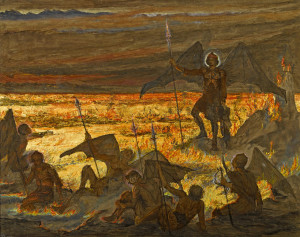
Demetrios Galanis (1879 – 1966)
 Galanis was the most celebrated Greek artist working abroad in the twentieth century. Born in Athens, in 1900 Galanis moved to Paris, where his artistic talents would earn him the highest accolades, which saw him appointed full professor at the École des Beaux-Arts (School of Fine Arts) and academician at the Académie française (French Academy). Galanis created a series of wood engravings for the 1931 Cresset Press edition of Paradise Lost, and the Satan imagined by Galanis certainly recalls the Miltonic Satan of Romantic art: Satan’s muscular nude form calls to mind most Romantic renderings of Milton’s Satan, and the character’s bulky stature is particularly reminiscent of Barry’s Satan, his stoic expression reminiscent of Westall’s Satan Alarmed—Dilated Stood (1794). However, Galanis’ Satan also harkens back to proto-Romantic artwork as well: Satan’s short, disheveled hair reminds one of the fallen angel of Hayman’s 1749 illustrations for Paradise Lost, and the figure’s wings, while angelic, are rather miniscule, recalling the very first illustrations for Paradise Lost of 1688, namely the depiction of Satan for Book I. With Galanis’ Satan, then, we come full circle.
Galanis was the most celebrated Greek artist working abroad in the twentieth century. Born in Athens, in 1900 Galanis moved to Paris, where his artistic talents would earn him the highest accolades, which saw him appointed full professor at the École des Beaux-Arts (School of Fine Arts) and academician at the Académie française (French Academy). Galanis created a series of wood engravings for the 1931 Cresset Press edition of Paradise Lost, and the Satan imagined by Galanis certainly recalls the Miltonic Satan of Romantic art: Satan’s muscular nude form calls to mind most Romantic renderings of Milton’s Satan, and the character’s bulky stature is particularly reminiscent of Barry’s Satan, his stoic expression reminiscent of Westall’s Satan Alarmed—Dilated Stood (1794). However, Galanis’ Satan also harkens back to proto-Romantic artwork as well: Satan’s short, disheveled hair reminds one of the fallen angel of Hayman’s 1749 illustrations for Paradise Lost, and the figure’s wings, while angelic, are rather miniscule, recalling the very first illustrations for Paradise Lost of 1688, namely the depiction of Satan for Book I. With Galanis’ Satan, then, we come full circle.
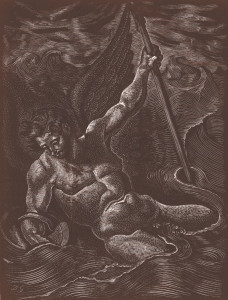
The post-Romantic Paradise Lost illustrations included here exhibit residual traces of the Miltonic Satan’s pictorial apotheosis, just as the Romantic reimagining of Milton’s fallen archangel was anticipated by proto-Romantic illustrations of the poem. The original 1688 illustrations for Milton’s epic, however, fell far short of bringing its Satan to life on account of the overwhelming medievalist imagery of bestial monstrousness and/or buffoonery—an image which of course the Devil would be returned to in the twentieth century. As the Romantic artists at long last fully grasped the magnificence of Milton’s portrait of Satan in Paradise Lost in ways previous illustrators simply did not, by the early twentieth century illustrators of Milton had begun to drift away from the Romantic vision, and in the popular culture Satan would subsequently begin slipping back into his horrific guises of yore. The Devil’s visual retrogression would be crystallized by a new artistic medium that ascended in the twentieth century: cinema.
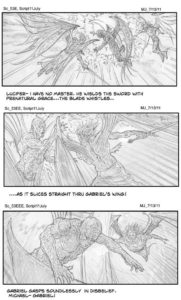 While elements of the Miltonic are broadly evident in film, Milton’s Paradise Lost has never made it to the silver screen, though the desire to attempt an adaptation was present since cinema’s inception. (See Eric C. Brown, Milton on Film.) Instead, twentieth-century cinema provided plenty of Devils for mass audiences to be terrified by, such as the eerie, unseen demonic force at work in horror classics such as Rosemary’s Baby (1968), The Exorcist (1973), and The Omen (1976), or ill-willed Devils-made-flesh in films such as Angel Heart (1987), The Devil’s Advocate (1997), and End of Days (1999), wherein Satans played by high-profile actors are after souls, or are out to corrupt the world by proliferating evildoers, or are hell-bent on actualizing Armageddon. And then there are of course the comedic Devil films, wherein Lucifer has been treated lightheartedly, such as Angel on My Shoulder (1946), Bedazzled (1967; remade 2000), and The Witches of Eastwick (1987), which render the supreme rebel as little more than an amusingly endearing malcontent. So while cinema has produced numerous onscreen Satans—disembodied force of evil, Mephistophelean tempter, salacious femme fatale, eerie child, playful prankster—filmgoers have not yet been exposed to Milton’s epic hero Satan. A film adaptation of Paradise Lost was nearly realized just a few years back, but the project was ultimately derailed at the eleventh hour on account of the distended budget this ambitious attempt demanded—or, as the would-be director suspects, on account of the controversy the film might court over its sympathetic portrayal of Satan, which suggests a Romantic treatment of Milton’s story. The failure of this Paradise Lost film to materialize is the latest installment in a long line of thwarted efforts to adapt Milton’s epic imagery to onscreen spectacle; however, it is also reminiscent of certain Romantic artists’ ambitious but frustrated Miltonic projects, such as Fuseli’s failed Milton Gallery (1799–1800) or Barry’s unfinished series of illustrations for Paradise Lost, which the defunct film’s storyboards and concept art call to mind.
While elements of the Miltonic are broadly evident in film, Milton’s Paradise Lost has never made it to the silver screen, though the desire to attempt an adaptation was present since cinema’s inception. (See Eric C. Brown, Milton on Film.) Instead, twentieth-century cinema provided plenty of Devils for mass audiences to be terrified by, such as the eerie, unseen demonic force at work in horror classics such as Rosemary’s Baby (1968), The Exorcist (1973), and The Omen (1976), or ill-willed Devils-made-flesh in films such as Angel Heart (1987), The Devil’s Advocate (1997), and End of Days (1999), wherein Satans played by high-profile actors are after souls, or are out to corrupt the world by proliferating evildoers, or are hell-bent on actualizing Armageddon. And then there are of course the comedic Devil films, wherein Lucifer has been treated lightheartedly, such as Angel on My Shoulder (1946), Bedazzled (1967; remade 2000), and The Witches of Eastwick (1987), which render the supreme rebel as little more than an amusingly endearing malcontent. So while cinema has produced numerous onscreen Satans—disembodied force of evil, Mephistophelean tempter, salacious femme fatale, eerie child, playful prankster—filmgoers have not yet been exposed to Milton’s epic hero Satan. A film adaptation of Paradise Lost was nearly realized just a few years back, but the project was ultimately derailed at the eleventh hour on account of the distended budget this ambitious attempt demanded—or, as the would-be director suspects, on account of the controversy the film might court over its sympathetic portrayal of Satan, which suggests a Romantic treatment of Milton’s story. The failure of this Paradise Lost film to materialize is the latest installment in a long line of thwarted efforts to adapt Milton’s epic imagery to onscreen spectacle; however, it is also reminiscent of certain Romantic artists’ ambitious but frustrated Miltonic projects, such as Fuseli’s failed Milton Gallery (1799–1800) or Barry’s unfinished series of illustrations for Paradise Lost, which the defunct film’s storyboards and concept art call to mind.
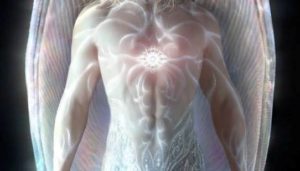 Cinema, which was destined to become the most popular visual medium, has been saturated with Satans either medievally monstrous or lightheartedly comical, and so despite the abundant risks involved in a film adaptation of Milton’s Paradise Lost, it is to be wished that the Miltonic-Romantic Lucifer will at long last have the opportunity to stake his flag on cinematic soil, which would expose modern-day mass audiences to this grand tradition. Paradise Lost as a blockbuster movie could be an incredibly important advancement in the Miltonic-Romantic legacy of Lucifer: the film would in all likelihood end up being a major cultural event, and the Satan who’d be its star would almost certainly define the Devil for a generation; if handled properly, this cinematic Satan could prove to be the most significant post-Romantic visual incarnation of Milton’s fallen archangel yet.
Cinema, which was destined to become the most popular visual medium, has been saturated with Satans either medievally monstrous or lightheartedly comical, and so despite the abundant risks involved in a film adaptation of Milton’s Paradise Lost, it is to be wished that the Miltonic-Romantic Lucifer will at long last have the opportunity to stake his flag on cinematic soil, which would expose modern-day mass audiences to this grand tradition. Paradise Lost as a blockbuster movie could be an incredibly important advancement in the Miltonic-Romantic legacy of Lucifer: the film would in all likelihood end up being a major cultural event, and the Satan who’d be its star would almost certainly define the Devil for a generation; if handled properly, this cinematic Satan could prove to be the most significant post-Romantic visual incarnation of Milton’s fallen archangel yet.